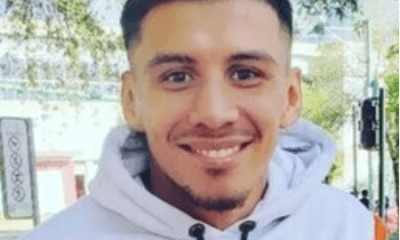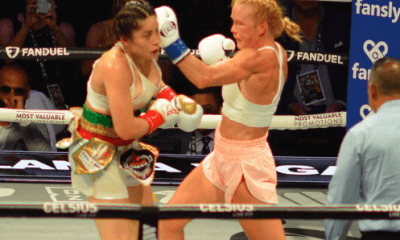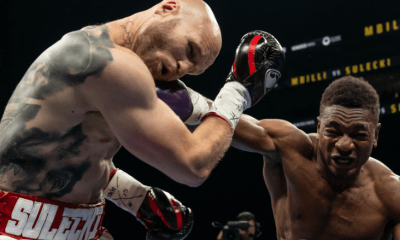Featured Articles
Mark Kram Jr, Author of a New Bio of Joe Frazier, Pays Homage to his Father

Mark Kram Jr, Author of a New Bio of Joe Frazier, Pays Homage to his Father
When it comes to writing about sports, the Kram duo, father and son, have produced many notable works.
The late Mark Kram, whose byline ran in Sports Illustrated from the mid-1960s through the late-1970s, delivered some of the most melodic prose this side of Red Smith.
His son has followed in his footsteps. Known as a longform specialist and a columnist, Mark Kram Jr. is also the author of several books. “Like Any Normal Day: A Story of Devotion,” won the 2013 PEN/ESPN Award for Literary Sports Writing, and he is the author of the recently-released biography, “Smokin’ Joe: The Life of Joe Frazier.”
Having a successful father can sometimes be daunting for the offspring. Has the last name opened more doors than it’s closed?
“It’s been far more of a help than a hindrance,” Kram Jr. (pictured) said in an e-mail. “Of course, we shared the same byline for years while I worked in newspapers. That led to some awkwardness. Understandably, people would call thinking I was him. When I began writing for Philadelphia magazine in the 1990s, I adopted “Jr.” to clarify who was who.
Technically, I am not a “Jr.” He changed his name from “George” to “Mark” three years after I was born in 1956, when he started covering high school sports for the Baltimore Sun.”
Kram Jr., whose efforts have appeared in “The Best American Sports Writing” series and in “The Great American Sports Page: A Century of Classic Columns From Ring Lardner to Sally Jenkins,” an anthology edited and selected by John Schulian, said that although his father made an impact in journalism, it didn’t necessarily propel him into the business.
“Not particularly,” he said of his ultimate career choice. “When it came to writing, I was very much a late bloomer, as Dad himself had been. He neither encouraged nor discouraged me. When I got to college at the University of Maryland, I told myself that if I could learn to write while I was there, it would be a skill that could keep me gainfully employed in the years to come. So I began working for the college newspaper. But like Dad, I was more or less self-taught.”
The elder Kram passed away in 2002 at age 69. That he accomplished what he did is remarkable, given where he began.
Born in Baltimore, Maryland, on December 6, 1932, Mark Kram wasn’t blessed with a silver spoon in his mouth. Books and high-brow literature weren’t laying around the house. The Daily Racing Form and tout sheets were.
Kram was a three-sport athlete in high school who went on to play minor league baseball. His hopes of playing in the big leagues were dashed when he was beaned. He was drafted into the military in 1953 and spent a very short period of time at the University of Georgia.
Kram would find work at Sports Illustrated where he became one of its rising stars.
Boxing was Kram’s primary beat and it coincided with the time Muhammad Ali, along with Joe Frazier and George Foreman, dominated the heavyweight division.
“Well, he came along during a period that is looked upon now as the golden age of Sports Illustrated,” said Kram Jr. “For a young man who had finished tenth from the bottom of his high school class and had no college to speak of, he was on a very fast track when he got to New York in 1964. But he worked very hard to develop his skills and just became better and better.”
Kram Jr. went on: “Along with his boxing pieces, he took on an array of off-beat bonus pieces that enabled him to grow artistically,” he said. “I remember he told me he once had lunch with Joseph Mitchell, the legendary New Yorker writer. Dad was interested in moving over to the New Yorker. Mitchell told him, “That can be arranged. But why would you want to? Everything is happening where you are.”
On some level, it may appear that writing is something that anyone can do. Maybe? But it’s another matter to write well.
“Dad used to say he was as fast as he had to be. For Ali-Frazier I and II, he had an hour to write his stories and he did it,” said Kram Jr., who was a senior writer for the Philadelphia Daily News from 1987 through 2013. “When he was working on something longer, he tended to bleed over every comma. At his office at Sports Illustrated, he would type a few lines, get up and pace the halls, thinking.”
Kram Jr. continued: “As he walked, he would puff on his pipe. By the time he was finished writing, the back of his shirt would be soaked with sweat. Remember, he worked on a typewriter as opposed to a computer screen, which is an inherently slower process. Even so, it would never have come easy for him, just as it would never become easy for me.”
The elder Kram’s piece de resistance was his Sports Illustrated story on Ali-Frazier III filed on deadline from Manila. Titled “Lawdy, Lawdy, He’s Great” (those words were uttered by Frazier about Ali after his trainer Eddie Futch threw in the towel just before the start of the 15th round), it ran as the S.I. cover story on Oct. 13, 1975 and was later expanded into a book, “Ghosts of Manila: The Fateful Blood Feud Between Muhammad Ali and Joe Frazier.”
What prompted Kram Jr., who was also employed at the Detroit Free Press and the Baltimore News American, to write his two books?
“The appeal of that story to me,” he said, referencing his first book, “was how ordinary people found themselves caught up in extraordinary circumstances. The principal subject of the story, Buddy Miley, had severed his spinal cord in a high school [football] game in 1973. I interviewed him for the Philadelphia Daily News in early 1993. He had lived as a quadriplegic for 20 years, his every need seen to by his mother Rosemarie at their suburban Philadelphia home.”
Kram Jr. added: “Four years later after I wrote about him, he was found dead in a Michigan motel room. He had been assisted in his suicide by Dr. Jack Kevorkian. Buddy had talked his younger brother, Jimmy Miley, into taking him to Michigan in what would become an act of complicated love,” he said. “Fearing reprisals from the authorities, Jimmy had kept his role to himself until he sat down with me for a piece in 2006. The story ended up on HBO Real Sports and would become the foundation for the book I would publish in the spring of 2012.”
Kram Jr. added: “‘Like Any Normal Day’ enlarged the struggles of a heretofore anonymous family into something universal. If you looked hard enough at the characters in the book, you could see yourself in one of them. In “Smokin’ Joe: The Life of Joe Frazier,” I was with characters who were just the opposite. Frazier was internationally known. The challenge for me was to bring to his life a certain degree of intimacy.”
Regarding his father’s famous story, this is what Richard Deitsch, a longtime Sports Illustrated writer and current scribe at The Athletic, tweeted on June 4, 2016, the day after Ali passed away at age 74. “I consider this Mark Kram piece on Muhammad Ali and Joe Frazier the best piece in the history of @SI.com.”
“Simply, it is a lovely piece of skillful writing,” said Kram Jr. “The opening sequence of it is haunting; Ali and Frazier had placed their bodies on the line, had given every ounce of their resolve, and now they were both exhausted and battered. From there, the story shifts perspective and point of view almost line by line; you can feel the energy in it building to a crescendo. Reflecting upon it as a piece of event reporting, a Sports Illustrated editor called it ‘the apotheosis of the form’. I would agree.”
There is a link between father and son when it comes to Frazier. It seems that because of Ali’s towering presence, Frazier has been somewhat overlooked.
“Is he? I think you have to judge athletes in the context of their era,” Kram Jr. pointed out. “To my way of thinking, the 1960s and early 1970s were the golden age of heavyweights. The talent pool was very, very deep. Frazier was on the smallish side for a heavyweight – far smaller than his chief rivals, Ali and Foreman – yet he was the consummate overachiever who never backed up an inch. Though Ali and Foreman both beat him twice, he acquitted himself with courage even in defeat. I have no idea how he would have fared against Jack Dempsey or Joe Louis or Rocky Marciano. No one else does either.”
Father and son are wonderful story tellers. What makes one so? “Curiosity; the desire to tug at loose threads until you come across one that leads somewhere intriguing; the ability to subordinate yourself to the subject you are writing about,” Kram Jr. said. “Nothing gets me to put a story down faster than the overuse of the first person. Generally, your presence in a piece of writing should be felt, not seen.”
Kram Jr. added: “Plus – and this is paramount – you have to have patience, the willingness to take the necessary time to get something the way it should be. There is a sign I keep over my desk that says ‘Things of Quality Have No Fear of Time.’”
Kram Jr. edited and chose a collection of his father’s best work titled, “Great Men Die Twice: The Selected Works Of Mark Kram,” published in 2015.
Looking back, is Kram Jr. glad he initiated the project? “Very much so,” he said. “Few journalists have written as gorgeously as he did. Some of his sentences are pure poetry. He was quite deserving of a collection. I only wish it had been longer.”
The last time father and son saw each other was June 8, 2002 when Lennox Lewis knocked out Mike Tyson in the eighth round of their title fight with three belts on the line.
“(Dad) had done a Playboy interview with (Mike) Tyson and figured that Tyson was worthy of a book,” Kram Jr. said. “I joined him in Memphis for the fight. We had both arranged for credentials, but when we showed up in the press tent to get them, there was only one for Mark Kram. I remember it was funny. The young fellow handing out the credentials looked at Dad, then looked at me and said, ‘so there ARE two of you!’ We had a lot of fun that week in Memphis driving around and hitting the spots. But the fight was awful. Even from our seats up in the stands, it was clear that Tyson was finished. Lewis wiped the floor with him. Five days later Dad died of a heart attack back in Washington.”
What does Kram Jr. think his father would want people to most remember about him?
“Like I tend to think about Joe Frazier, a good but not a perfect man,” he said. “That is perhaps the best any of us can do.”
Check out more boxing news on video at The Boxing Channel
To comment on this story in The Fight Forum CLICK HERE
-

 Featured Articles3 weeks ago
Featured Articles3 weeks agoAvila Perspective, Chap. 330: Matchroom in New York plus the Latest on Canelo-Crawford
-

 Featured Articles2 weeks ago
Featured Articles2 weeks agoVito Mielnicki Jr Whitewashes Kamil Gardzielik Before the Home Folks in Newark
-

 Featured Articles4 weeks ago
Featured Articles4 weeks agoAvila Perspective, Chap 329: Pacquiao is Back, Fabio in England and More
-

 Featured Articles3 weeks ago
Featured Articles3 weeks agoOpetaia and Nakatani Crush Overmatched Foes, Capping Off a Wild Boxing Weekend
-

 Featured Articles2 weeks ago
Featured Articles2 weeks agoCatching Up with Clay Moyle Who Talks About His Massive Collection of Boxing Books
-

 Featured Articles4 weeks ago
Featured Articles4 weeks agoFabio Wardley Comes from Behind to KO Justis Huni
-

 Featured Articles1 week ago
Featured Articles1 week agoMore Medals for Hawaii’s Patricio Family at the USA Boxing Summer Festival
-

 Featured Articles4 weeks ago
Featured Articles4 weeks agoDelving into ‘Hoopla’ with Notes on Books by George Plimpton and Joyce Carol Oates





















